Dog crates have a bad reputation. I’ve seen them referred to as “imprisonment” or “puppy jail”. As a force-free dog trainer that strongly believes in both animal welfare AND crate training, I wanted to clear up some of the misconceptions I’ve been reading! Crate training your puppy will make both of your lives easier.
Crate training is not mean. It is not punishment.
By crate training your dog you’re actually giving them their own space to feel safe and comfortable! You like having your own space, right? Why wouldn’t your puppy?
What we will cover in this article:
- Why crate training is a good thing for both you and your puppy
- How to choose a puppy crate
- My two biggest rules for crate training
- How to introduce the crate properly
- Suggested crate training schedule
- Tips for trouble-shooting crate training issues you may have
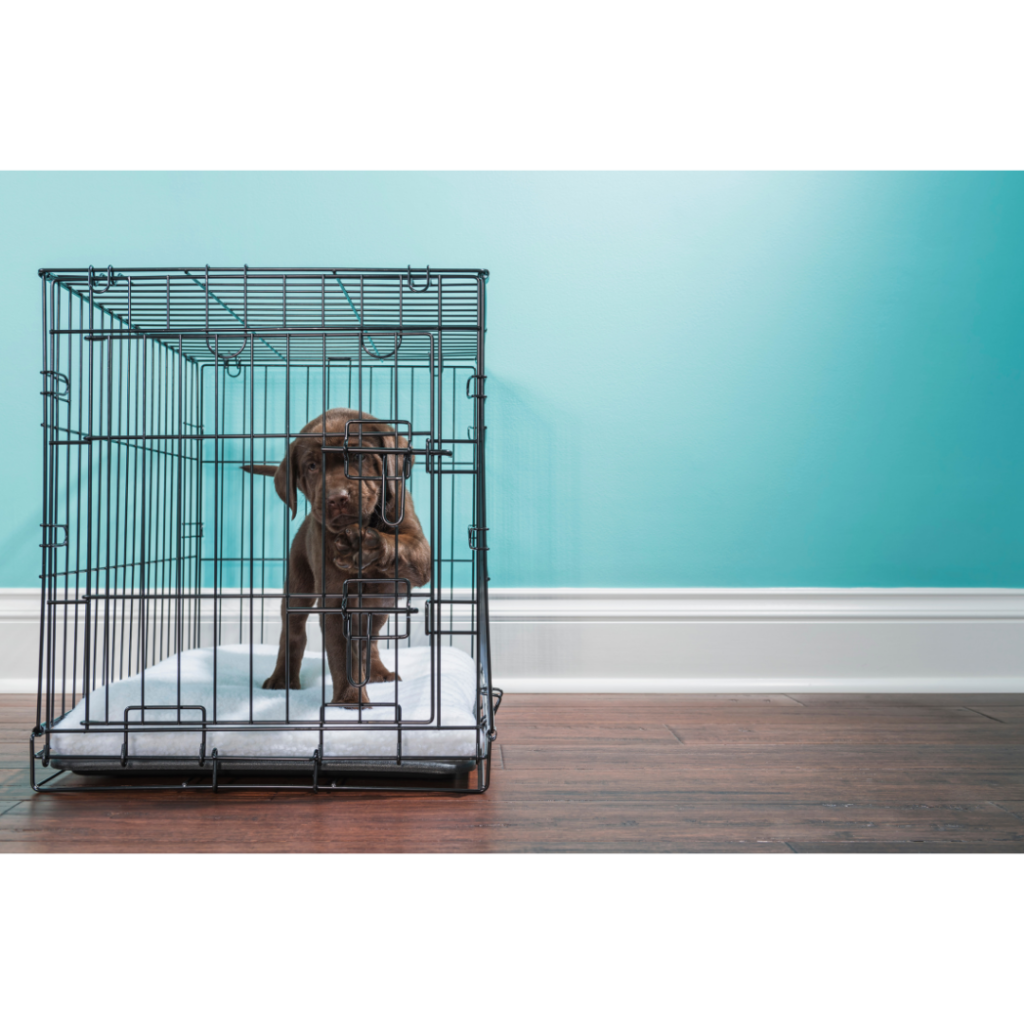
Crate training your puppy is a good thing!
Crates are not “puppy prisons”.
If you’ve had older dogs you will likely notice that they often try to lie underneath things such as the coffee or kitchen table. This is because dogs are den animals and prefer resting in a safe shelter.
Rather than thinking of the crate as putting your puppy in prison, think of it like sending them to a cozy hotel!
Properly introduced crates are calm, comfortable, safe places where your pup will WANT to rest. My dog is now ~ 8 years old and we still keep her crate because she chooses to go into it for naps!
I try to explain to clients that a crate is similar to giving your dog a bedroom. It’s a nice space that’s just for them!
Benefits of crate training:
- Crates help puppies meet their sleep requirements! Puppies need a LOT of sleep. An 8 week old puppy requires ~ 20 hours of sleep per day! Puppies develop quickly, and they need enough rest for their brain development to keep up. Sleep deprived puppies have smaller brain mass and more behavioural issues. Extreme sleep deprivation can even lead to puppy death. Just like toddlers, puppies can’t be expected to regulate their own sleep needs however. Puppies are also adorable and it can be hard for us to ignore them enough for them to nap when they’re free! This is particularly true in homes with kids. Following a crate schedule provides your puppy with a safe, relaxed place to meet their sleep requirements.
- Crate training is essential for potty training your puppy! Puppies are born with the instinct to not go to the bathroom where they sleep. Prevention of accidents is crucial to potty training! Therefore, keeping your puppy in their crate when you cannot supervise them with dramatically increase the speed of potty training. It’s important to get the right size crate however, because your puppy may mess in the crate corner if there’s enough space for them to “get away from it”.
- Crate training helps keep your puppy (and house!) safe. Puppies explore the world with their mouths. This is normal! However, an unsupervised puppy may chew or swallow items that are unsafe for them. Crate training will keep your puppy safe by limiting their access to items unsupervised.
- Crate training can help prevent separation anxiety! When you crate your puppy you’re helping them learn how to self-settle in a safe place independent of you. When introduced and done properly, this structured independence can go a long way in preventing separation anxiety. Puppies are adorable; I get it! However, if you’ve never taught your puppy to feel secure when they’re away from you you’re setting them up for unneeded anguish in the future.
How to choose a crate:
Choose a crate that will fit your puppy once they’re fully grown. Otherwise, you are just going to need to keep buying new crates as your pup gets bigger. For tiny breeds this is fairly straightforward! What about for the larger breeds though?
If your puppy is going to grow substantially with age, I suggest using a crate with a divider. Buy a crate that they’ll fit in when full grown, but section it off to match their needs right now. Remember- you want the crate to be large enough for them to comfortably lie down but that’s it. Any larger and you’ll have a more difficult time with potty training.

Fabric crates are nice for travel once your dog is older, but during crate training always use a hard sided crate! This guarantees they will be kept safe and secure. Both metal or plastic crates work well, but metal are easier to divide for bigger breeds.

To make the crate more comfortable I suggest using old towels or t-shirts to line the bottom. If possible, use something that smells either like you or like the puppies mom to increase your puppy’s comfort. There are also machine washable crate pads that you can purchase, but I would wait until your confident your pup won’t destroy them!
To minimize distractions and help your pup sleep, you can also consider draping a sheet over the crate and using a white noise machine!
Many people also swear by using a Snuggle Puppy for new pups! It has a real-feel heart beat to help comfort puppies!

My two biggest rules when crate training your puppy:
I have two big rules when it comes to crate training:
- ALWAYS associate the crate with positivity! Puppies can learn to love their crate, but in order for that to occur the crate always needs to be associated with a positive, safe place to go. You’re going to spend time properly introducing the crate (I’ll explain how soon). Make sure you don’t undo all that effort by using the crate as punishment. Ever! That sounds simple, but it’s a mistake I often see. Perhaps your puppy has messed in the house or was getting a little too land-sharkish with their puppy biting. You feel frustrated and want to stick them in their crate for a break. It’s understandable, but resist! The crate always needs to be a safe, happy place rather than a jail cell. Resist hastily putting your pup in the crate! Take a breath, throw a treat into the back of the crate for your puppy to voluntarily follow into the crate, then close the door. It’s important you never put your puppy in their crate for punishment.
- NEVER let your puppy out when they’re whining or barking. This rule can be hard to follow through on, but it’s very important. Dogs and puppies repeat what gets reinforced. If making a fuss in their crate gets them freedom, they will do it again! Think of it like a toddler in a toy store. If they throw a tantrum and get a toy, do you think they’ll throw a tantrum the next time? Likely! It can be hard to ignore you puppy when they’re barking, whining or fussing but it’s very important! Later in this article we’ll discuss what to do if your puppy continually fusses in their crate.
How to properly introduce a puppy crate:
Every dog is going to respond differently to crate training.
Many breeders and rescues will start the crate training process, so your puppy may be quite comfortable in a crate before you get them.
Unfortunately, it’s also possible that your puppy or dog was exposed to a crate in a negative way.
Either way, with time & persistence you can get your pup to like the crate!
How do you make the crate a positive thing for your puppy?
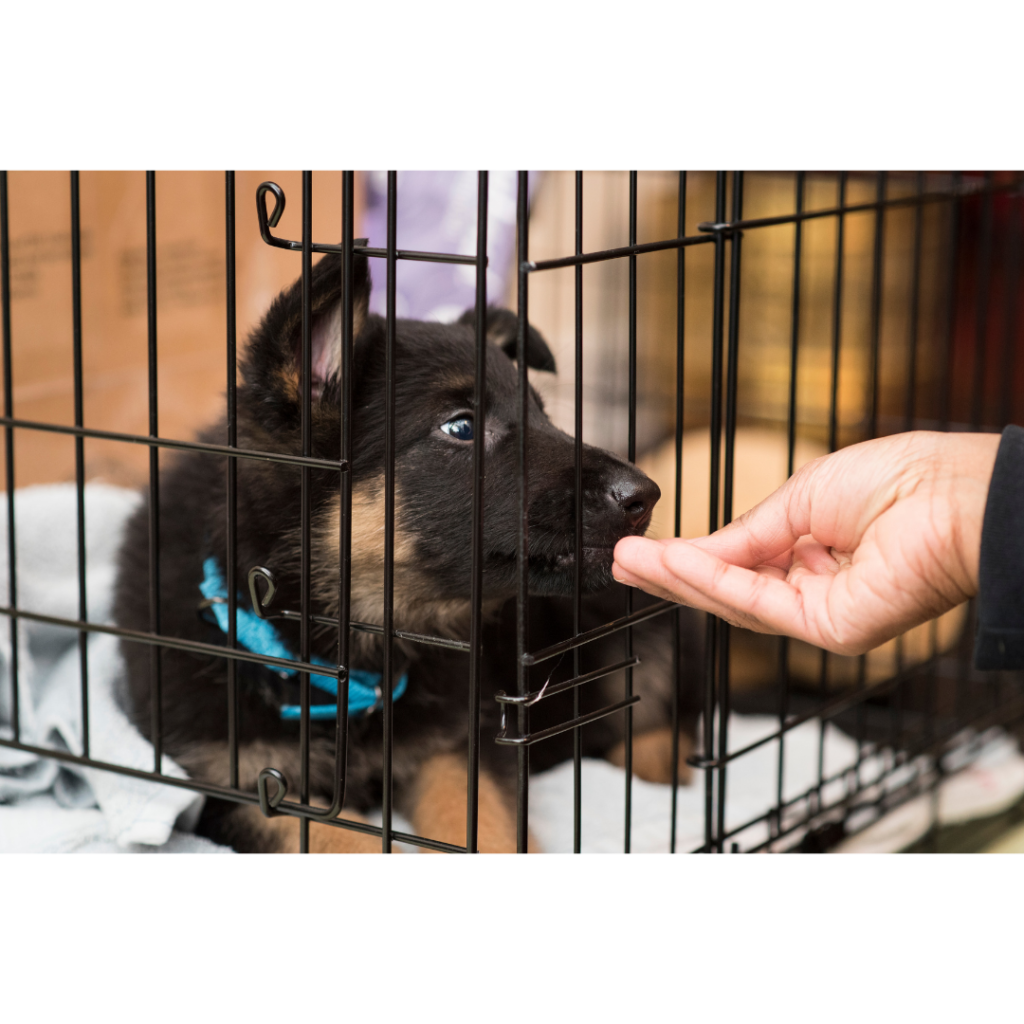
To make the crate positive, you will pair crate interactions with food/treats which is a primary reinforcer.
What’s a primary reinforcer? By definition it’s a stimulus that is biologically important to an organism. In simple terms? It’s something naturally appealing to your dog without needing to be taught! Let’s look at another example.
Exercise/going outside is naturally rewarding for dogs. Therefore, it’s a primary reinforcer. When first introduced, a dogs leash is a neutral object. Over time however, the dog gets excited when they see their leash. They’ve associated that leash = walk!
To make the crate positive for your puppy, we’ll use treats/food. It will also eventually represent shelter & sleep!
Progressing to extended periods of time in the crate will likely take multiple days. When properly introduced the crate will become a safe place your puppy will want to go!
Step 1: Introduce the crate
- Start getting your pup to voluntarily enter and explore the crate! Toss treats near the crate, just inside it, and then further into the back of it. Progress how far into the crate your throw the treat based on your puppies comfort level. We’re just trying to get your puppy comfortable around/in the crate right now, so do not lock them in yet!
- Feed all meals in the crate. Puppies are normally fed three times a day, so this is 3 opportunities to build positive associations every day!
Step 2: Closing your puppy in the crate for short periods of time
- During meal times, start closing the door behind them as your puppy reaches their food dish. Hang out next to the crate as they eat, then open the door as soon as they finish their meal (BEFORE they start to fuss)!
- Start practicing tossing a treat into the back of the crate and say “crate”. This begins to build a verbal cue. As they enter the crate, say “Yes” (or whatever your marker word is). Close the door briefly behind your pup. Open it before they start to fuss.
Step 3: Start increasing the duration that your puppy is in their crate
Practice crating your puppy numerous time every day! The more you practice, the faster your puppy will take to their crate.
- Offer a longer-lasting treat in their crate! Start with leaving your puppy in their crate with the item for 10 minutes, and work up gradually. Examples of entertaining items include bones, bully sticks, a frozen peanut butter stuffed kong, or a fun dog puzzle.
- Continue providing meals in the crate, but walk away once the crate door is closed. Keep your pup crated for 30 minutes after each meal.
- Remember to always have your puppy voluntarily enter the crate rather than being put inside! You’ve been building up the cue “crate” by saying it as you toss a treat inside. Once it seems like your puppy is starting to know the command, try saying it without tossing the treat. Immediately say “yes” and reward them for entering!
What about overnight crating?
I suspect after reading the steps above you recognize that it will likely take a few days to properly expose your puppy to their crate. You’re right; for almost all puppies this isn’t going to be something that happens in one day.
So, what are you supposed to do on the first night they’re home? If you crate them, isn’t that a contraindication to properly introducing the crate at a pace they’re comfortable with?
Unfortunately, yes it is! However, the reality is that they need to be crated overnight to be kept safe and prevent potty accidents.
Try to introduce the crate as much as possible the first day you have them, but recognize that the extended duration of being in a crate overnight is something they’re likely going to protest for a few days.
The first few nights having a new puppy can be rough and fairly sleepless. This is normal!
I suggest placing the crate next to your bed at night for the first few nights to decrease your puppies social isolation. Remember- they’re used to being with their siblings and mom! It’s going to take a few days for them to adjust. You can also try a Snuggle Puppy! The heart-beat sensation can be comforting and many people swear by them for new puppies!
Take them for a potty break right before bedtime. Toss a treat in their crate and have them voluntarily enter. They will likely whine out of loneliness throughout the night. Try to resist talking to them or hushing them. Instead, it can be helpful to extend your hand or sleep near them so they can smell you and know they’re not alone.
During the day a basic rule of thumb is that your puppy can hold their bladder for ~ 1 hour for each month of age. Therefore, a 2 month old puppy can hold their bladder for 2 hours on average. Overnight, this can often be extended slightly. I suggest setting an alarm for every few hours to take your puppy out for a pee BEFORE they start whining to go out. This reinforces calm, quiet behavior in the crate because they won’t be given a valid reason to whine (a full bladder!).
Suggested crate training schedule:
This is an example of a schedule for an 8 week old puppy that has been properly introduced to the crate already! Remember that young puppies need a LOT of sleep (18-20 hours a day). So while this may look like a lot of time in the crate, young puppies need to meet their sleep requirements! Not all naps need to be in the crate (for example if your puppy falls asleep next to you on the couch that’s fine!) but make sure you’re providing adequate quiet time for naps.
Sample schedule:
Puppy sleeps in crate overnight. Take outside immediately upon waking.
Breakfast & crate for 30 minutes. Potty.
One hour play & cuddle time. Potty.
Chew or nap in crate for 1 hour. Potty.
Lunch & 30 minutes in crate. Potty.
One hour play & cuddle time. Potty.
Chew & nap in crate for 2 hours. Potty.
Dinner & 30 minutes in crate. Potty.
Evening cuddles and play. Potty.
Overnight in crate.
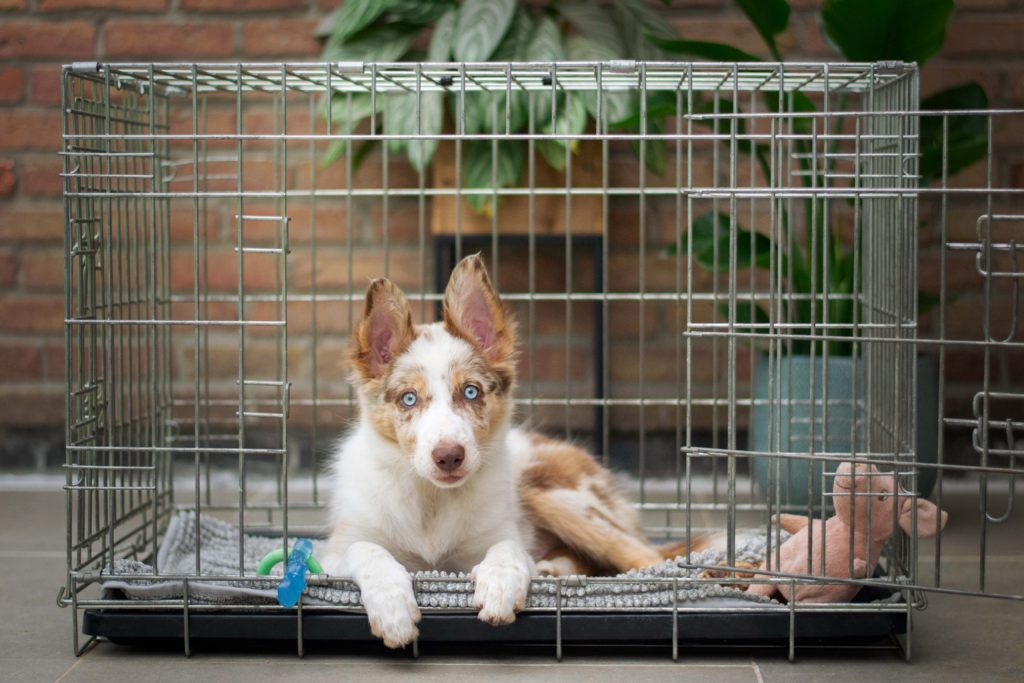
Tips for trouble-shooting issues you may have:
Is your puppy still whining or barking in the crate? At your wits end about what to do? Here are a few common mistakes to consider!
- Do you ONLY crate your puppy at night and still expect them to be quiet? Overnight is a long time for a puppy that’s not used to their crate. It’s important to crate them during the day too so that there are much shorter crate durations mixed in.
- Do you ever talk to your puppy or let them out when they’re fussing? What gets reinforced gets repeated! Do not give affection or let your pup out when they’re fussing. If your pup is whining or barking and you want to let them out, stand there and wait for them to stop. When they stop fussing for even a few moments, let them out.
- Do you leave them in their crate so long that they’re likely whining for a bathroom break and you feel like you need to let them out right away? Instead, start setting an alarm to remind youself when your pup will likely need a bathroom break! This way you can let them out while they’re still being calm rather than waiting until they’re whining out of true need.
- Do you ever put your puppy in their crate hastily or as punishment? Putting your puppy in the crate rather than training them to voluntarily enter can build negative associations and make it more like “puppy jail”. Even if you’re frustrated or rushed, throw a treat into the crate calmly to entice them in. It’s very, very important that the crate is only associated with positive things so that your puppy likes being there. Everyone likes their own room; no one likes feeling imprisoned somewhere they don’t want to be.
- In very rare cases, barking can be a self-rewarding behaviour for some dogs. Consider all the points above and also whether your pup is sufficiently exercised (mentally and physically)? If yes, that’s the only time I suggest correcting crate barking. To do so: when your puppy is barking try a verbal interrupter such as “Ahah!” (OR waiting for a couple second pause in their barking). As soon as they go silent, mark & reward it! They’ll likely immediately bark again, so repeat this process always capturing and rewarding the quiet moment. People will often correct their puppy for fussing, but forget to praise the silence that follows. Make sure you do both or you’re not actually teaching them how you WANT them to act in the crate.
Crate training can take some patience to properly establish, but it is very beneficial for both you and your dog!
You want your puppy to ENJOY going to their crate. Who doesn’t like having their own space??
Crates allow your dog to have the safety, proper sleep, and comfort that they need!
Happy training 🙂
Disclosure: Happy Hounds uses affiliate links. Purchasing with these links will not cost you any extra, but I get commissions for purchases made through these links. Affiliate links help me to continue to offer free resources & blog posts. I would love if you used them!
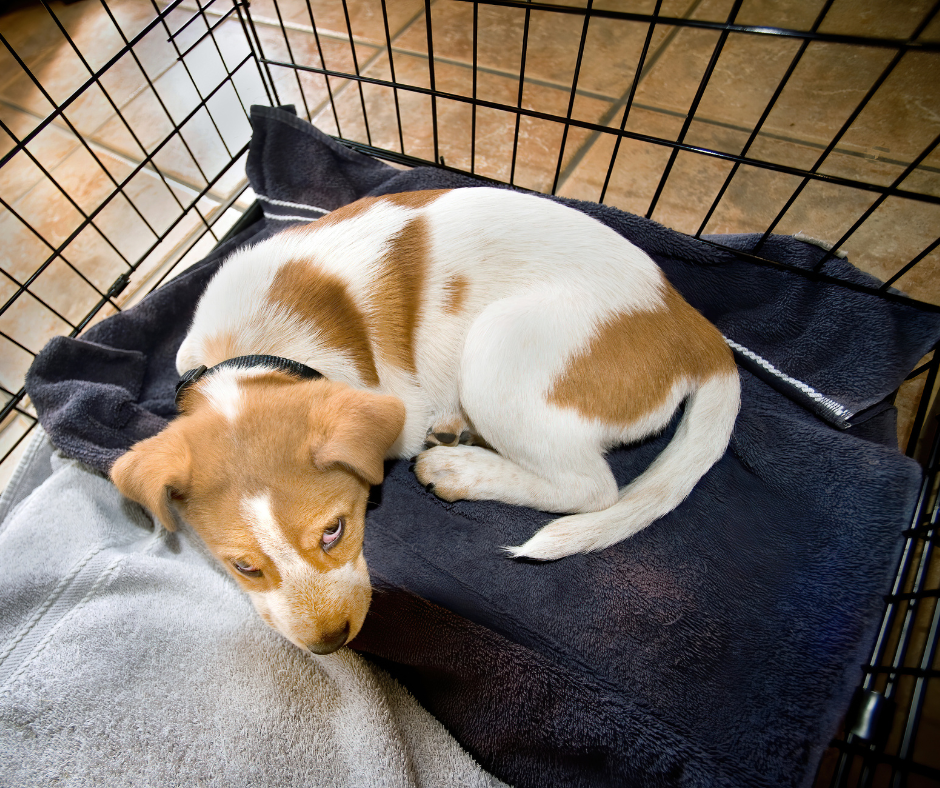
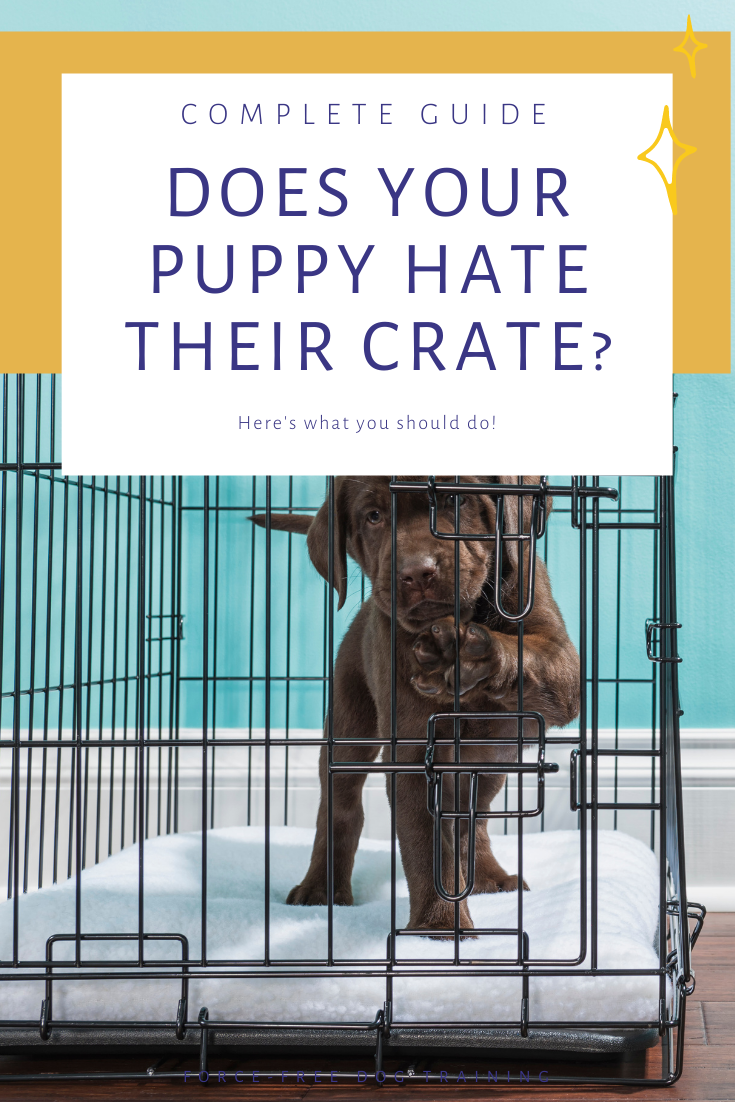
Im very pleased to find this site. I need to to thank you for ones time for this particularly fantastic read!! I definitely really liked every part of it and I have you bookmarked to see new information on your site.
Thank you so much for the kind words! 🙂